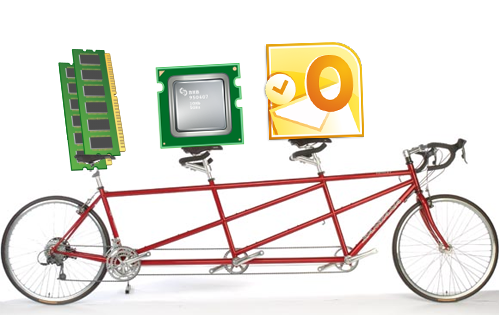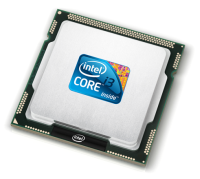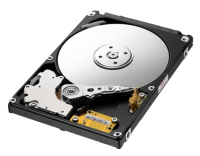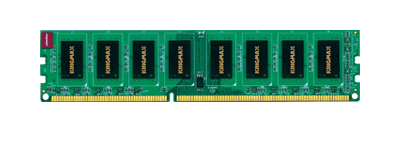8
Outlook crawling at snail’s speed? – How your hardware directly impacts Outlook’s speed –
No comments · Posted by Bogdan in Email & Outlook
Tags: hardware requirements · outlook speed · pc components · speed problems · what do CPU RAM HDD mean
Computers are expensive – that’s a fact! Any upgrade or new version of this hardware or that software will bring about a rapid decline in your financial status. That’s exactly the reason why all our articles detailing Outlook’s speed and optimizations until now have dealt with software tweaks (turn this thing off, disable that thing), but what if you’re on a budget and want to upgrade your PC so that it performs better in the daily tasks Outlook has lined up? What to upgrade first so that Outlook’s speed improves and how does each component benefit your email workhorse?
In the following article we will try to explain what a computer is made of and how the hardware interacts with Outlook, either giving it wings or putting it under a leash. So, if you’re an advanced PC user and already know the basics, just head on to one of our other posts and see how easy it is, with the help of a few tweaks, to significantly improve Outlook’s speed and responsiveness, or take a look at our product line – we’re sure you’ll find something to your liking!
5 quick fixes that help when Outlook is slow
Reduce your PST file size easily by sending email attachments to the cloud
Top 11 reasons for duplicate emails in your Outlook Inbox
Instead of deleting, move attachments from Outlook to a folder automatically!
The CPU – The brains behind the operation
Unless your last dealing with PCs was in the 1950s, you must have heard this acronym: CPU. CPU stands for Central Processing Unit, and it refers to those tiny metal squares (microprocessors) that Intel or AMD are releasing every year or so.

The CPU is actually the most important part of any computer (and usually the most expensive), its features influencing everything from games to Outlook’s speed, general loading times and so on. The CPU is responsible for all the operations and calculations that you do on the PC (just like the brain of any animal). So, the speedier it is (measured in Giga Hertz nowadays), the faster it will work – this is because the CPU contains only a small set of instructions and everything has to be performed by them. A real-life example would be clicking the “New E-Mail” button in Outlook – if you’re on an older system, you can take a sip of coffee in the time it takes to display the new window, on a newer one it being almost instantaneous.
Unfortunately, each new generation of CPUs brings with it a new socket, so normally you can’t install newer chips on your more-than-two-year-old PC (they won’t fit). Thus, if you want a cheap upgrade so that Outlook’s speed increases you will have to look elsewhere. Normally, by following the tips provided in an older article of ours you can get reasonable speeds for Outlook on even a 1GHz CPU, but don’t expect miracles. Anything in excess of 1.8 GHz will be enough for the job, but you should still tweak Outlook’s settings, just to make sure. You can check your CPU model and speed by right-clicking the My Computer icon, then selecting Properties.
Even if Outlook boasts of supporting CPUs with 500 MHz (1000 MHz = 1 GHz), Outlook’s speed and responsiveness will suffer greatly – it’s like taking the kids’ bike to visit some relatives in a different state. It gets the job done, but you’d better pack sandwiches, water and a blanket!
Hard-Disk-Drives – The place to be!
All your music, photos, games and programs, all the data that the CPU manipulates is stored on your hard-disk-drive.

Just like with all PC components, HDDs have come a long way – I still remember reading in 1996 about the next generation models, boasting 2 gigabytes of storage space (1 Gb = 1000 Mb; a song has around 5 Mb, a HD movie upwards of 10 Gb… you do the math 🙂 ). Of course, you can’t ever have too much space for your pictures of the pets and kids, but always remember that Outlook’s speed is also related to the free space left on your HDD. When you open Outlook, it will take up some of that free space to load its files, so if you have only a few MB of free space Outlook’s speed will be awful or it will refuse to work whatsoever.
It’s quite easy to fix this: either burn a couple of DVDs and free up some space for Outlook or just buy another HDD – they’re easy to install, also come in the external USB variety, and you can use as many of them as you like at the same time (you don’t have to take the old one out, or reinstall everything and thus, lose time and data).
Outlook’s speed and operability will increase up to a point, so before you spend any money give it a run with at least 2 Gb of free space. Also, all new HDDs are backwards-compatible with PCs from even 7 years ago, so you should buy the one with the largest capacity that you can afford.
RAM Memory – The more the merrier!
If you’re on a budget, then this is the best way of obtaining a significant speed increase in Outlook!
When you launch a program (any program, not only Outlook), it first loads in a special place named RAM (Random-Access-Memory) – these are memory chips which deliver much faster speeds than your hard-drive, so that your CPU doesn’t have to wait as long to access its most used data. The more programs you have running, the more RAM is used; when there’s no more, the data is written to the HDD which will drag Outlook’s speed down and down, to a standstill.

The good news is that they’re separate components and can be taken out and exchanged for better ones easily, even by novices at home (here’s a short movie explaining just how – YouTube). RAM chips are very cheap, but you may need to search around a bit until you find one compatible with really old computers, but trust me – it’s worth it! Not only will Outlook perform faster, everything will load and work better!
You should have at least 1 Gb of RAM for all of Outlook’s speed improvements and features to work, but in order to actually use them in a timely manner you will need around 2 Gb. Just think that Outlook automatically disables stuff if you don’t have enough RAM!
Microsoft’s requirements page informs us that Outlook 2010 will actually function with only 256 Mb of RAM available, but there’s quite a big difference between functioning and you being able to get work done. With only 256 Mb of RAM, Outlook’s speed will be dreadfully slow and the graphics features, Outlook Instant Search, Outlook with Business Contact Manager, Communicator, and certain advanced functionality will just be unavailable. If you have 512 Mb, then all of the above will be turned on (to the detriment of Outlook’s general speed), but Outlook Instant Search and grammar and contextual spelling will not – this requires at least 1 Gb.
From the above three types of components, more RAM memory definitely comes out as the winner. There’s no other way to drastically improve both your system’s and Outlook’s speed for so little money!
Now, if you’re all set and Outlook still behaves slowly, then there may be other reasons in the background. In this case, I recommend taking a look at one of our feature-packed add-ins, Weight Diet for Outlook. No matter the PC, if you don’t take constant care of Outlook, its speed will decrease over time. What our add-in does is optimize its internal workings so it loads faster, performs quicker and lets you finish your work on time! All our purchases come with a 30-day money back guarantee, so why not give it a spin and see how speedy your emails can be?
If you have ever sent out an email newsletter, I’m sure that with each passing campaign you encountered people who opted out of your email list. Have you ever asked yourself why? Read more: Why do people unsubscribe to emails? | 1 Comment
The subject line in an email, almost as much as the from line, is one of the most important deal-breakers for your readers. That’s why this week we looked at how different email clients (on all platforms we could get our hands on) dealt with them… So, continue reading and see for yourself how many characters your subject line should have! Read more: The maximum displayed length of the email subject line | 1 Comment
In last week’s article, we hoped to convince you that the from line is at least as important as the subject line in all your email communications. Now, to help you out, we tested different platforms and came up with the following “cheat-sheet”, detailing the maximum displayed length of the from line on different browsers, phones and desktop applications! Read more: The maximum displayed length of the email from line | 2 Comments
No comments yet.
<< Send all your email greeting cards in under 5 minutes and be prepared for the coming holidays!
